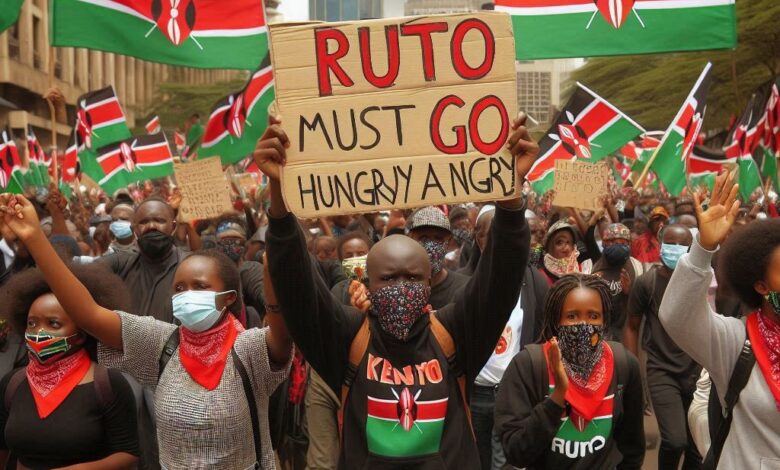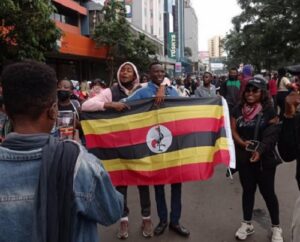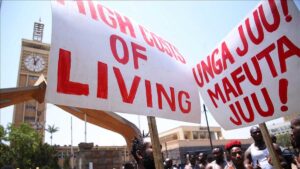
Nairobi. Kenya, once a beacon of hope for democracy in East Africa, now finds itself tightly gripped by creeping authoritarianism under President William Ruto. This transformation has followed a pattern of consolidating power by employing divide-and-rule tactics that include spreading lies, dismantling institutions, and suppressing dissenting voices.
When young people, notably Millennials and Gen Z, took to the streets in droves on June 18 to protest the tax-raising Finance Bill 2024, few expected their actions would resonate beyond Nairobi, Kenya’s economic and political capital.
The youth-driven uprising against rampant corruption, bad governance, and irresponsible leadership cloaked in opulence and arrogance inspired similar movements across borders, including recent protests in Nigeria under #EndBadGovernance and in Uganda with #EndCorruption.
The demonstrations, now a full-blown youth movement, have gained momentum due to their intensity and widespread participation. This surge of activism is fueled by broader discontent among Kenyans, which resonates with their frustrations over economic hardships, including the high cost of living and political disillusionment.

Despite the state’s brutal crackdown on protesters, the movement has rekindled hope in the fight against government overreach. It forced President Ruto to reject the controversial tax-raising bill, dismiss his cabinet (except for the foreign affairs minister), and pledge to implement austerity measures, including scrapping budgets for his and his deputy’s spouses’ offices.
However, doubts persist about the president’s commitment to these promised reforms, especially with the perception of an increasingly weakened opposition and a Parliament that has effectively become a rubber stamp for his administration.
The Gen Z movement has emerged as the toughest challenge to President Ruto’s leadership since he assumed office in September 2022. During his swearing-in, President Ruto pledged that his administration would uphold the rule of law and reject extrajudicial killings, enforced disappearances, and police excesses.
However, his response to the Gen Z protests, which culminated in the storming and burning of a section of Parliament on June 25—a powerful expression of widespread disapproval of an administration seen as unresponsive to calls for better governance and accountability—signaled a sharp departure from his earlier dismissive stance on demonstrations.
The deployment of the military alongside the police, despite widespread concerns about its constitutionality, highlighted the extreme measures he was willing to take to maintain his grip on power.
Initially appearing shaken and subdued, Ruto’s tone and demeanor hardened as he addressed the nation that evening from the steps of the State House, in the aftermath of the youths’ storming of Parliament. He condemned the protesters as “criminals” and “anarchists,” accusing them of committing treason.

Political Fortunes and Sponsored Violence, Infiltration, Brutality, and Undermining Activism
A windfall of political fortune swept through Ruto’s administration when Raila Odinga, his long-time adversary, and opposition strong-man, unexpectedly threw his support behind the president.
This sudden endorsement, delivered at a critical moment, provided Ruto with fresh political legitimacy and a renewed license to stifle dissent with near impunity.
In his first public rally since the parliamentary incursion, a radicalized Ruto vowed to end the protests, declaring, “I have given everyone a chance to say whatever they want. But it cannot continue like this,” he told residents of Bomet County. “From now on, we will protect the nation, safeguard lives, and stop the looters and anarchists. I promise you, it’s going to stop.”
Ruto’s strategy to suppress criticism and consolidate support became multifaceted. He continued to employ both traditional and covert tactics such as broad daylight abductions, police brutality, arbitrary arrests, and incommunicado detention to isolate, co-opt, or crush the nationwide opposition.
His main goal was to dismantle the youth-led movement and stifle its influence using the state’s absolute power. His message was clear: dissent and defiance will be dealt with ruthlessly as long as he is president.
Insidious tactics were also used to infiltrate the movement and sow division. He exploited the movement’s leaderless and non-tribal nature to undermine its internal solidarity.
Government-affiliated influencers used hashtags such as #CrushAnarchists to intimidate those resisting co-option, instilling fear among young protesters who were not accustomed to the state’s aggressive tactics against dissent.
Those approached by Ruto’s networks have revealed that the president’s online network targeted and exerted pressure on prominent social media influencers deemed linked to the movement’s digital lifeline, attempting to coerce or incentivize them into denouncing the protests.
On the streets, the state normalized violence by having hired goons infiltrate demonstrations, vandalize, destroy property, and steal, all to delegitimize the protests and label them as “anarchists”.
These actions obviously violate basic human rights and represent deliberate efforts to reinforce the state’s absolute power, disregarding the protections enshrined in Article 37 of Kenya’s 2010 Constitution.
This effort aimed to fracture the movement and weaken its ability to communicate effectively while at the same time discredit public trust in its concerns and legitimacy. By blurring the line between the public’s grievances and the government’s narrative, Ruto succeeded in slowing the movement’s momentum.
He managed to create an environment where some Kenyans now believe he has addressed their concerns and needs more time to fulfill his other promised reforms.
President Ruto’s push of the country towards authoritarianism should serve as a cautionary tale. Yet, even amid this dark chapter in our country’s history, the spirit of resistance must remain a duty, not an option.
The fight for democracy and freedom continues, and the nation’s future will depend on the courage of its citizens to stand against the tide of tyranny.

From “Outsider” to Autocrat: Ruto’s Broken Promises and Double-Faced Shift Approach
In broad daylight, President Ruto presents himself as a man of the people—amiable, honest, and all draped in Pharisees’ righteous robes. However, beneath this polished exterior, lies a master of political deceit—exceptionally manipulative, precise, and always ready to strike without hesitation.
He has a low threshold for dissent and swiftly rejects any challenges to his views. He surrounds himself with yes-sir-men who echo his every decision. His charm masks a divisive and vengeful resolve; a leader who, in his quest for dominance, is deeply entangled in his own half-truths he peddles daily.
About two years ago, in the lead-up to the August 2022 election, Ruto and his Kenya Kwanza political team exploited the “Hustler vs. Dynasty” narrative, to garner widespread support from those frustrated by persistent inequality.
He framed the Kenyattas and Odingas as symbols of the elite responsible for the nation’s poverty, a stance that nearly set the country on fire along social and economic lines.
He presented his rise from a humble chicken seller in Sugoi, Uasin Gishu County, as that of an outsider, without any political godfather. Unlike the tribal politics that have dominated previous elections, he used this polarizing narrative to persuade Kenyans to elect him to the highest office, positioning himself as a savior with a profound understanding of the struggles faced by the majority poor.
This potentially divisive narrative served almost as his primary proof of his commitment to bringing about economic justice once he was in the State House.
But once in office, Ruto’s approach shifted dramatically. Firstly, he formed a cabinet from his political allies, contradicting his campaign promise to represent “mama mbogas” and “boda bodas,” which had been central to his political appeal and secured him the presidency.
Secondly, he conveniently forgot his earlier claim that a robust opposition was crucial for accountability—an ideal he championed during his campaign and reiterated in his first media interview after winning the presidency.
Thirdly, he also suddenly found himself unable to avoid borrowing and increasing taxes—a stance he had vehemently criticized his predecessor for, worsening the economic situation for those he had promised to rescue and deliver them to economic paradise.

Deliberate Undermining of Checks and Balances
Contrary to his promise to uphold checks and balances, Ruto systematically embarked on weakening through co-opting opposition politicians to secure a majority in Parliament that would unconditionally support his policies with minimal resistance.
With the latest support of Odinga, the longest-serving opposition leader and now a political ally, along with his Orange Democratic Movement (ODM)—the second largest party in Parliament after Ruto’s ruling party—the formation of a ‘broad-based and inclusive government’ has delivered a decisive blow to meaningful opposition, both within and outside Parliament, effectively dismantling the institutions of checks and balances.
He has also effectively consolidated his 2027 re-election strategy despite soaring living costs, mounting national debt, and a string of broken promises.
Even before securing the opposition in his pocket, Ruto had already launched incessant attacks against the judiciary. Once a cornerstone of Kenya’s democracy, the judiciary has faced relentless assaults from Ruto and his Kenya Kwanza lapdogs whenever its rulings have been perceived unfavorable.
This pattern of attacks intensified after a three-judge bench declared Ruto’s 2023 Finance Act unconstitutional due to procedural errors on July 31.
This ruling is just one of several overturned decisions since the Ruto administration took over, and it cast doubts on the quality of legal advice he continues to receive, all while aiming to advance his development agenda.
Parliament has threatened to cut the judiciary’s budget if it continues to challenge legislative actions. At the same time, outside Parliament, Ruto and his allies accuse some judicial officers of corruption and collusion with certain civil society groups to undermine his effort to transform the country.
Co-optation, Media Censorship, and the Erosion of Civil Rights
Media and journalists are also targeted in this effort to undermine institutions that could challenge the government. Media houses and prominent journalists face coordinated tactics, including the withholding of advertisement revenue, intended to co-opt or isolate critics.
Privately owned national media outlets like Citizen Television, Nation Media Group, and Standard Group have faced state-sponsored online threats. Media houses that resist government pressure have recently received warning letters from the Communication Authority of Kenya.

Journalists who dare to report on government malfeasance face harassment, censorship, or worse. The recent example of John Alan Namu’s exposé on the fertilizer scandal underscores this tactic. The message is clear: in Ruto’s Kenya, the press either serves the state or suffers the consequences.
Kenya’s civil and political rights, once a hallmark of its democratic identity, are now under severe threat. Freedoms to protest, speak freely, and assemble are being eroded systematically under Ruto’s increasingly authoritarian rule.
Protesters are met with excessive police force, while dissenting voices are silenced through intimidation or worse. Independent institutions tasked with protecting human rights have been compromised or co-opted into supporting the government’s agenda, often at the expense of justice and accountability.
Towards a Crossroad: Kenya’s Fragile Democracy
In Kenya, democracy hangs by a thread. Ruto’s systematic erosion of democratic principles, unchecked by a weakened opposition, is pushing the country towards a crisis. If this authoritarian drift continues, Kenya risks becoming a full-blown autocracy where freedom and democracy exist only in name.